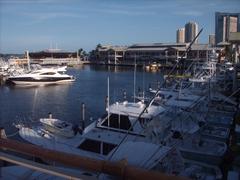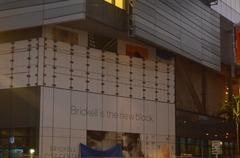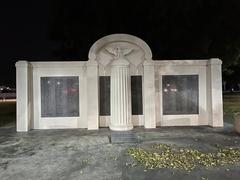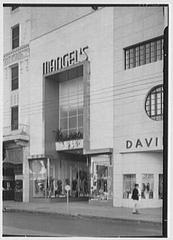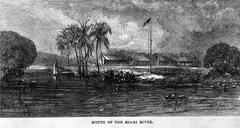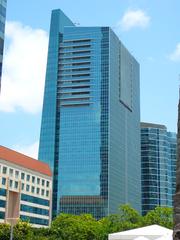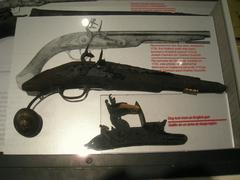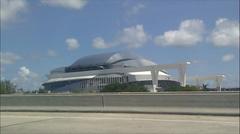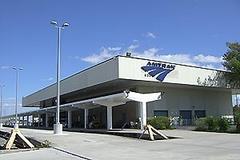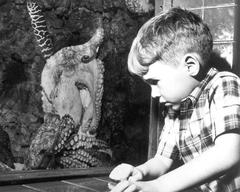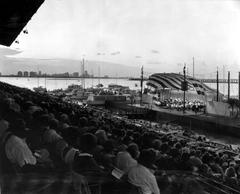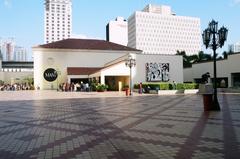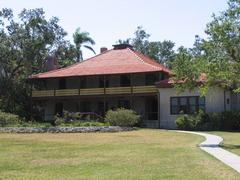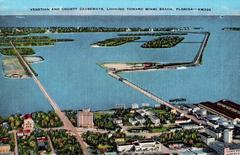
Civic Center Miami Visiting Hours, Tickets, and Historical Sites Guide
Date: 04/07/2025
Introduction to Civic Center Miami
Miami’s Civic Center, also known as the Health District, is a vibrant urban neighborhood that has grown from its early-20th-century roots—marked by the founding of Jackson Memorial Hospital in 1915—into the nation’s second-largest hub of medical and research facilities, after Houston’s Texas Medical Center. The district is a cornerstone of Miami’s urban identity, blending historic architecture, state-of-the-art medical innovation, and cultural diversity. Visitors will discover landmarks such as the Jackson Memorial Hospital’s Alamo Museum, the University of Miami Leonard M. Miller School of Medicine, and the Bascom Palmer Eye Institute, all of which highlight the district’s role in healthcare, education, and research (miamistampedconcrete.com, in-miami.org, jacksonhealth.org, med.miami.edu, bascompalmer.org).
Civic Center’s accessibility, via the Metrorail Civic Center station and the free Miami Trolley Health District route, ensures seamless transit to downtown Miami, the airport, and neighboring arts and culture districts like Wynwood and Coral Gables (wikipedia.org, happymiamiexpats.com, miamiandbeaches.com).
This guide equips visitors with everything needed for a rewarding experience—covering visiting hours, ticketing, transportation, safety, cultural events, and practical tips—showcasing the Civic Center’s unique blend of history, innovation, and community.
Table of Contents
- Introduction
- Historical Development of Miami’s Civic Center
- Architectural and Institutional Significance
- Urban Identity and Growth
- Key Landmarks and Attractions
- Major Medical and Research Institutions
- Government and Civic Buildings
- Research and Innovation Hubs
- Cultural and Educational Landmarks
- Nearby Attractions
- Transportation and Accessibility
- Visitor Amenities and Services
- Architectural Highlights
- Safety and Accessibility Features
- Cultural and Community Insights
- Visiting the Historic District
- FAQ
- References
Historical Development of Miami’s Civic Center
The Civic Center’s transformation began in the early 1900s, centered around Jackson Memorial Hospital’s establishment in 1915 (miamistampedconcrete.com). This catalyzed the growth of Miami’s health district, attracting a range of medical, research, and governmental institutions. The district’s boundaries are defined by Northwest 20th Street and 14th Avenue to the northwest, the Dolphin Expressway and Miami River to the south and west, and the Midtown Interchange and Interstate 95 to the east, making it a central and accessible part of the city (in-miami.org).
Architectural and Institutional Significance
Civic Center’s architecture is a blend of historic and contemporary styles. The original Jackson Memorial Hospital “Alamo” building serves as a museum, preserving Miami’s early healthcare heritage (miamistampedconcrete.com). Today, the district includes modern research institutes, government offices, and clinics, emphasizing both preservation and innovation.
The partnership between Jackson Memorial Hospital and the University of Miami Miller School of Medicine, as well as the Florida International University Herbert Wertheim College of Medicine, has fostered a dynamic environment for education, research, and clinical practice.
Urban Identity and Growth
The Civic Center is seamlessly connected to downtown Miami via the Metrorail, promoting organized urban development and accessibility (resetarchitecture.com). European-inspired public spaces—alleys, courtyards, and parks—encourage community interaction. Public transit options, such as the Metrorail and Miami Trolley Health District route, link the Civic Center with other key neighborhoods.
Key Landmarks and Attractions
- Jackson Memorial Hospital’s Alamo Museum: A historical landmark open weekdays, 9:00 AM–5:00 PM, featuring exhibits on Miami’s medical history (miamistampedconcrete.com).
- University of Miami Life Science and Technology Park: Occasionally open for public lectures and events.
- Dade County Courthouse: Iconic 1928 building nearby, significant for its architecture and legal history (miamiwonder.com).
The Civic Center is also a gateway to neighborhoods like Wynwood and Coral Gables.
Major Medical and Research Institutions
- Jackson Memorial Hospital: One of the largest public hospitals in the U.S., renowned for trauma and transplant care. Tours are available by appointment (jacksonhealth.org).
- University of Miami Leonard M. Miller School of Medicine: A leading medical school with frequent public lectures and events (med.miami.edu).
- Bascom Palmer Eye Institute: The nation’s top ophthalmology hospital, offering public seminars and tours (bascompalmer.org).
- Miami VA Healthcare System: Serving veterans with comprehensive care and public outreach (va.gov/miami-health-care).
Government and Civic Buildings
- Richard E. Gerstein Justice Building: Miami-Dade’s main criminal courthouse with notable modernist design (jud11.flcourts.org).
- Miami-Dade Medical Examiner Department: Educational outreach and safety events are periodically available (miamidade.gov).
Research and Innovation Hubs
- University of Miami Life Science & Technology Park: A hub for biotech and healthcare innovation that hosts conferences and public events (umiamihealth.org).
- Scripps Research Institute (Satellite Facilities): Contributes to translational medicine and public health research.
Cultural and Educational Landmarks
- Civic Center Green Spaces and Public Art: Enjoy outdoor installations and green areas celebrating Miami’s diversity (upaclaim.org).
- Lois Pope LIFE Center: Home to neurological research and public events (themiamiproject.org).
- Miami Dade College Medical Campus: Offers public health fairs and community programs (mdc.edu).
Notable Nearby Attractions
- Marlins Park (LoanDepot Park): MLB stadium offering tours and games (mlb.com/marlins/ballpark).
- Historic Overtown and Little Havana: Cultural neighborhoods featuring festivals, art, and cuisine (miamiandbeaches.com).
Transportation and Accessibility
- Civic Center Metrorail Station: Central hub providing direct connections to downtown, the airport, and other districts (miamidade.gov).
- Miami Trolley and Bus Services: Free and affordable transit options for easy access (intrepidscout.com).
Visitor Amenities and Services
- Dining & Retail: Hospital cafeterias, local cafes, food trucks, and on-site retail make dining and shopping convenient.
- Hotels and Accommodations: A range of hotels serve medical tourists and visitors (miamiandbeaches.com).
- Public Events and Community Programs: Health fairs, educational seminars, and outreach events are held regularly (upaclaim.org).
Architectural Highlights
- Modernist and Functional Design: Blending accessibility and green integration to enhance visitor comfort.
- Local Art and History Integration: Murals, sculptures, and displays throughout the district honor Miami’s cultural diversity.
Safety and Accessibility Features
- Security: Well-lit areas and on-site security ensure safety.
- Accessibility: ADA-compliant design throughout major institutions.
Cultural and Community Insights
The Civic Center’s population is highly diverse, reflecting Miami’s multicultural makeup, with English, Spanish, and Haitian Creole widely spoken (wikipedia.org). Proximity to Little Havana and Allapattah infuses the area with Cuban, Dominican, and other Caribbean influences (happymiamiexpats.com). Community engagement is fostered through health fairs, educational programming, and affordable housing initiatives (umcivicengagement.miami.edu).
Visiting the Miami Civic Center Historic District
History and Monuments
The district’s historical evolution is tied to Miami’s growth, with Jackson Memorial Hospital and the University of Miami Medical Campus at its core. Public art, memorials, and preserved architecture offer insight into the city’s development.
Visiting Hours & Tickets
Most sites are open weekdays, 8 AM–6 PM. The Alamo Museum is free and open to the public during business hours. Some public lectures or events may require registration (med.miami.edu).
Tours & Photography
Guided tours are limited but occasionally available by appointment. The district is ideal for self-guided walking tours and photography of public art and historical exteriors.
Practical Tips
- Use public transit as parking is limited.
- Wear comfortable clothing and bring water, sunscreen, and a hat.
- Respect the privacy of patients and adhere to hospital protocols.
- Explore nearby neighborhoods for dining and cultural experiences.
Frequently Asked Questions (FAQ)
Q: What are the Civic Center’s visiting hours?
A: Most buildings are open Monday–Friday, 8 AM–6 PM. The Alamo Museum operates weekdays, 9 AM–5 PM.
Q: Are there entrance fees?
A: Most public areas and museums are free; some events or tours may require registration.
Q: How do I get there by public transport?
A: The Civic Center Metrorail station and Miami Trolley provide direct access.
Q: Is the area wheelchair accessible?
A: Yes, all major facilities are ADA-compliant.
Q: Are guided tours available?
A: Limited, but available for select institutions and events by advance arrangement.
Summary & Visitor Tips
Miami’s Civic Center is a distinctive destination where medical innovation, urban history, and multicultural vibrancy converge. Accessible by transit and rich in both landmark institutions and community spirit, the district is ideal for visitors seeking educational, cultural, or historical experiences. Plan ahead for visiting hours, make use of public transit, and engage with community events for a well-rounded visit (miamistampedconcrete.com, wikipedia.org, miamiandbeaches.com, happymiamiexpats.com, med.miami.edu, umcivicengagement.miami.edu).
For current event listings, tours, and travel tips, download the Audiala Miami Visitor App.
References and Further Reading
- miamistampedconcrete.com
- in-miami.org
- jacksonhealth.org
- med.miami.edu
- bascompalmer.org
- va.gov/miami-health-care
- miamiandbeaches.com
- wikipedia.org
- happymiamiexpats.com
- welcome.miami.edu
- historymiami.org
- jud11.flcourts.org
- miamidade.gov



